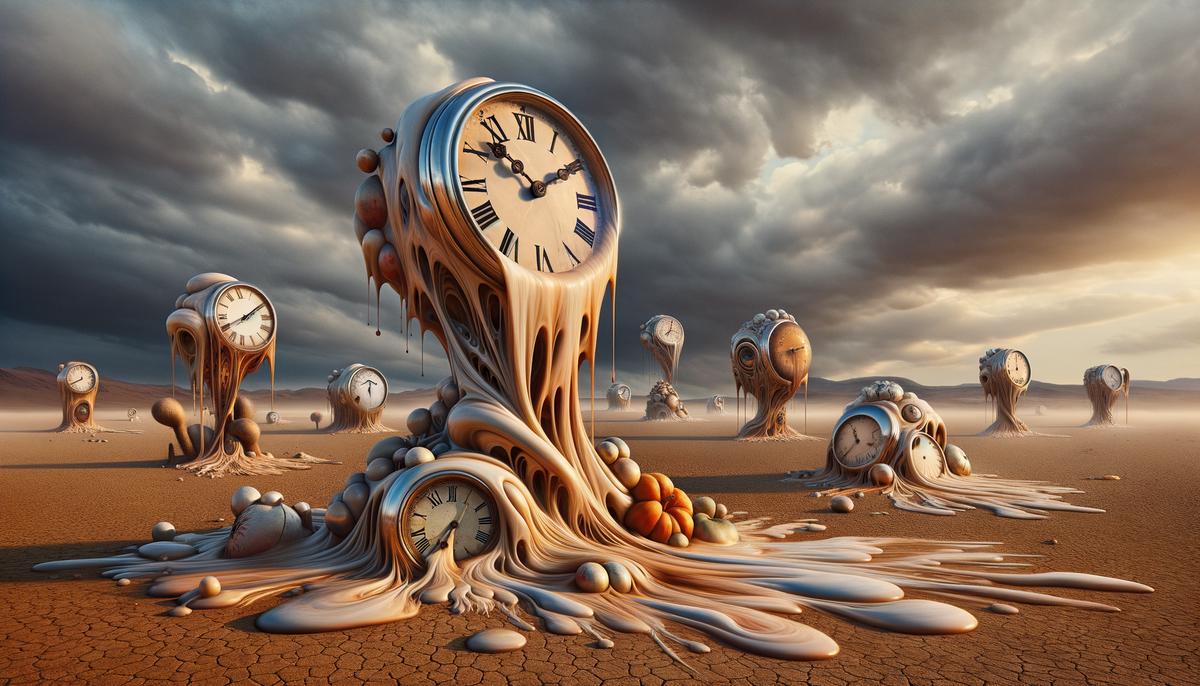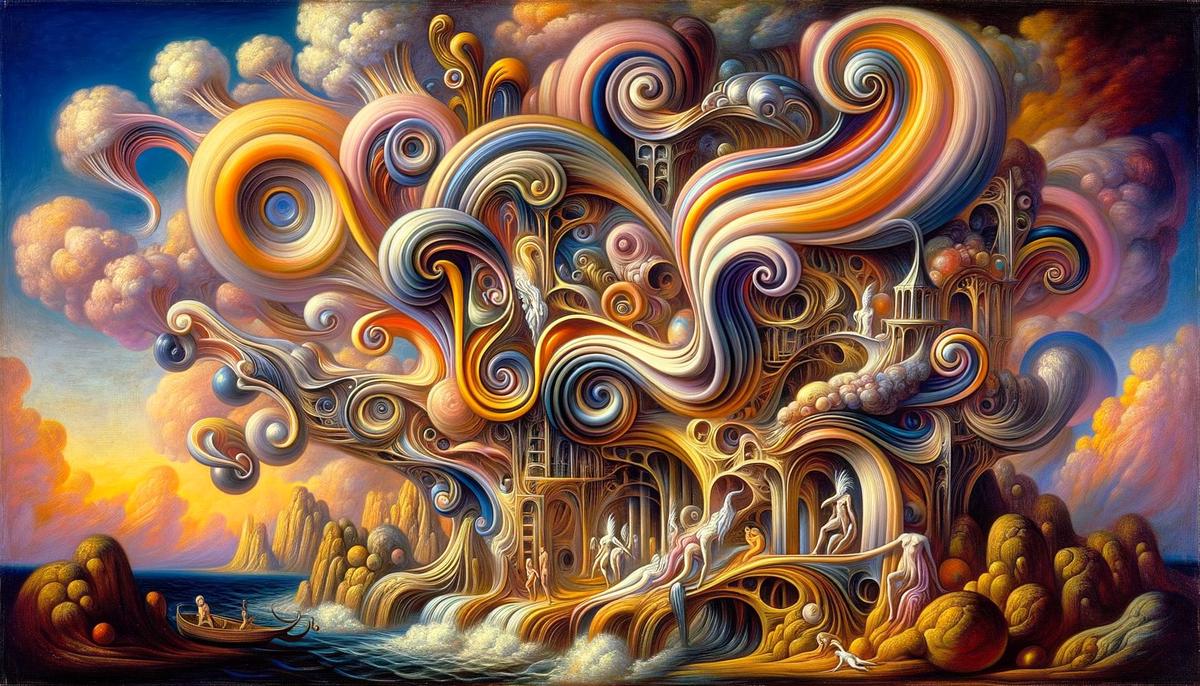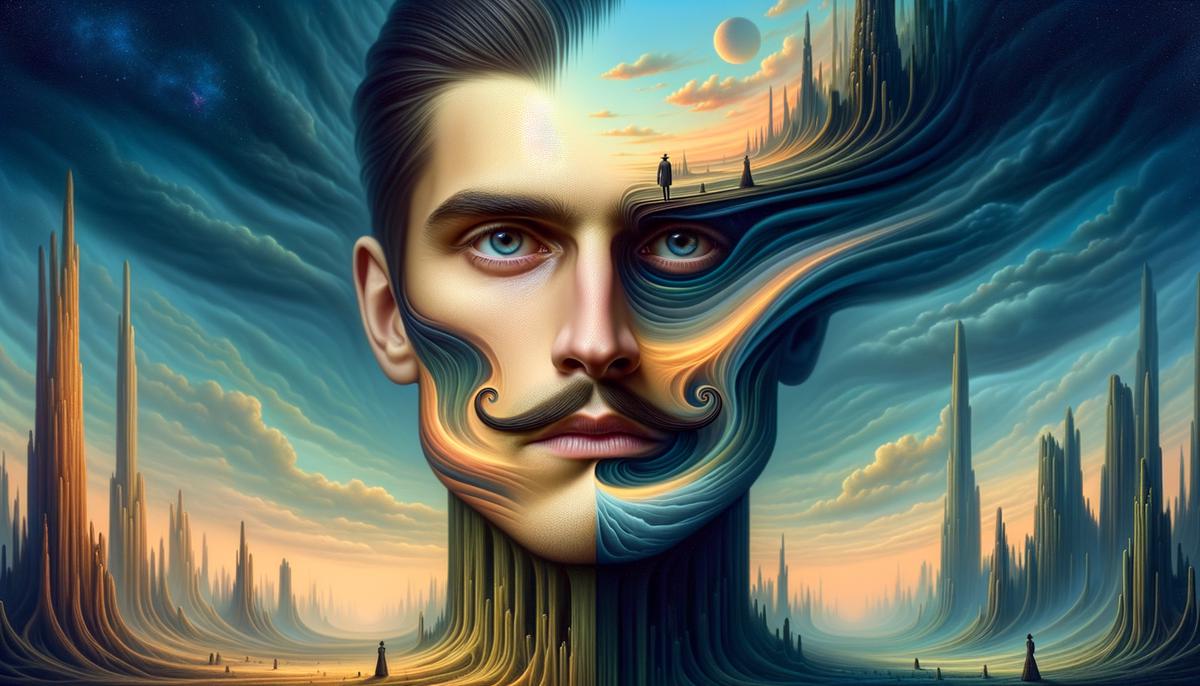Salvador Dalí’s artistic journey presents a narrative that intertwines personal evolution with the broader shifts in the art world. This article aims to shed light on how his experiences and the cultural environment of his time contributed to his distinctive approach to surrealism. By examining his works and ventures, we uncover the layers that define his legacy.
The Beginnings of Dalí’s Surreal Journey
Salvador Dalí’s journey into surrealism started early in his life when his love for painting began to develop. As a child, Dalí showed a keen interest in art, encouraged by his family. His first encounter with painting was through impressionist works which initially shaped his artistic expressions. However, Dalí’s insatiable curiosity led him to explore and eventually shift from Impressionism to a brief dalliance with Cubism. This phase was crucial as it opened Dalí up to the avant-garde, laying the groundwork for his future as a Surrealist icon.
Dalí’s move to Madrid to study at the Royal Academy of Fine Arts of San Fernando further broadened his artistic horizon. It was here that he came into contact with contemporary trends and solidified his reputation as an eccentric. But Dalí didn’t just rely on traditional education; he was also deeply affected by the broader cultural currents of the time, including the rising interest in the psychoanalytic theories of Sigmund Freud. Freud’s ideas on the unconscious, dreams, and the ego profoundly influenced Dalí, intertwining with his innate fascination with the dream world.
The pivotal moment came when Dalí embraced surrealism wholly, diving into the movement that sought to unleash the creative potential of the unconscious mind. His artworks began to feature bizarre dreamscapes and astonishing optical illusions, embodying the surrealists’ rejection of logic and conventional morality in favor of exploring the irrational and the taboo. Dalí’s painting “The Persistence of Memory,” with its soft, melting clocks against a desert landscape, became one of surrealism’s most iconic images, capturing the fluidity and bizarre logic of dreams.
Dalí’s collaboration with other artists and intellectuals in the surrealist movement, including Luis Buñuel and André Breton, further cemented his status within the movement. Yet, he was always somewhat of an outsider due to his flamboyant personality and controversial political views. His relationship with Gala, his wife, and muse, also played a significant role in his artistic development. She became a recurring subject in his work, symbolizing at once love, madness, and decay.
Moreover, Dalí’s surrealism wasn’t confined to painting. He ventured into a wide range of media, including film, sculpture, and photography, demonstrating an unparalleled capacity to cross boundaries and challenge perceptions. Through his innovative use of symbolism and meticulous technique, Dalí invited viewers into his fantastical world, making the absurd and surreal intimately tangible.
Through persistent exploration and a bold embrace of Freudian theories, Dalí navigated his path to becoming a leading figure in the Surrealist movement. His early life, marked by an evolving artistic journey – from impressionism through cubism to surrealism – reveals how personal experiences, combined with the cultural forces of his time, were assimilated into a uniquely Daliesque vision of the world. This approach not only pushed the boundaries of art but also ensured his enduring legacy as one of the most captivating and innovative artists of the twentieth century.

Iconic Works and Their Hidden Meanings
Dalí’s “The Elephants” is a remarkable piece that showcases his love for stretching the boundaries of reality and perception. In this painting, Dalí places slender-legged elephants atop oblong pedestals, a visual that not only challenges the laws of physics but teeters on the surreal edge of stability and fragility. These elephants, seemingly defying gravity, bring to light Dalí’s recurring theme: the contrast between the hard and the soft, the real and the surreal, the stable and the unstable. They are often interpreted as distorted symbols of strength and weight, carrying obelisks—representing power and success in ancient cultures—yet rendered almost powerless by their spindly, fragile legs.
Turning our gaze to another of his masterpieces, “Swans Reflecting Elephants,” we dive deeper into Dalí’s fascination with the unconscious mind. Here, Dalí employs a double image or a visual pun, where the swans on a serene lake reflect back as elephants in the dusk water. This clever use of reflection not only tricks the eye but delves into the duality of nature and the subconscious, highlighting his interest in mirroring the mind’s multifaceted layers. By exploring these spontaneous forms of duality, Dalí nods to his continual dance with the irrationality of human thoughts and perceptions, inviting viewers to question their understanding of reality.
Dalí’s method of creating art was as unique as his works themselves. He often employed what he called the “Paranoic-Critical Method,” a technique meant to induce a paranoid state, allowing him to access his subconscious and extract creativity from his fears and irrational thoughts. This approach led him to view everyday objects in multiple dimensions, transforming the mundane into the surreal within his art. It’s through this method that Dalí could conjure such vivid dreamscapes, filling them with symbols that delve deep into psychological explorations of time, memory, and the human mind.
The symbols in Dalí’s works—melting clocks in “The Persistence of Memory” or the elongated limbs and distorted figures in “The Elephants”—are not just whims of fancy but reflections of his intricate explorations into human psyche, dreams, and the continuity of time. The melting clocks, a familiar motif, suggest Dalí’s contemplation on the fluidity and arbitrary nature of time in our subconscious. In contrast, the exaggerated length of limbs and objects serves to distort perceptions of reality, pushing viewers to question the confines of their rationality and embrace the irrational.
Through these dreamscapes filled with bizarre juxtapositions and unsettling imagery, Dalí exposes his deep-seated interests in themes of decay, transformation, and rebirth—ideas heavily inspired by Freudian thought. He blurs the lines between what is real and what is imagined, between what we see and what we believe, crafting a surrealistic world where the only constant is the ever-present tick of time in its most abstract form.
In conclusion, by delving into Dalí’s famous works like “The Elephants” and exploring his unique artistic techniques, we uncover a world where every brushstroke speaks volumes about human nature’s complexity. His art becomes a gateway to understanding the inner workings of his mind—one flamboyantly decorated with melting clocks, distorted figures, and thought-provoking symbolism that guides us down the rabbit hole of his surreal imagination. Through Dalí’s lens, we are reminded that reality is but a canvas to our own subconscious, waiting to be reinterpreted and reimagined in ways that transcend the ordinary.

Dalí’s Multifaceted Artistic Ventures
Venturing beyond the easel and palette, Dalí delved into the cinematic world, merging his surreal visions with the moving image. His collaboration with Luis Buñuel on the film “Un Chien Andalou” is a testament to this, presenting a series of bewildering, dream-like sequences that jar the viewer’s sense of reality. This film, infamous for its eye-slicing scene, encapsulated Dalí’s desire to shock and provoke thought, firmly planting his flag in the medium of film.
Not stopping at film, Dalí’s creative partnerships extended into the sphere of Hollywood. Working with Alfred Hitchcock, he designed the dream sequences for the movie “Spellbound,” integrating his signature surreal imagery into the narrative fabric of the film. These sequences are lauded for their visual ingenuity and their ability to convey the complex layers of the human psyche, contributing significantly to the film’s acclaim.
Dalí’s artistic reach stretched into fashion as well, marking collaborations that blurred the lines between art and apparel. His work with Italian fashion designer Elsa Schiaparelli is particularly notable, producing pieces that merged high fashion with surreal art. Their Lobster Dress, adorned with a massive lobster painted by Dalí, is emblematic of this fusion, combining Schiaparelli’s design prowess with Dalí’s unconventional symbolism.
Moreover, his influence even permeated the realm of everyday objects. One of Dalí’s lesser-known but widely recognized contributions is the logo for Chupa Chups lollipops. Approached by the founder of Chupa Chups, Dalí designed a logo that was both playful and immediately recognizable, securing his influence in the pockets of countless consumers around the world.
Dalí’s sculptures further showcase his three-dimensional explorations of surrealism. “Space Elephant,” with its long spindly legs and obelisk-like structure atop its back, navigates the realms of the bizarre and the fantastic, translating Dalí’s dream-like visions into tangible forms.
In essence, Salvador Dalí’s creativity knew no bounds, transcending traditional mediums and showcasing his multifaceted talents across a spectrum of artistic endeavors. From the screens of cinemas to the luxurious textures of high fashion, from the public squares adorned with his sculptures to the hands of candy enthusiasts worldwide, Dalí’s influence is omnipresent. His ventures beyond painting not only underscore his versatility as an artist but also amplify the legacy of a man whose imagination reshaped not just art but the world around him.

Dalí’s Surrealism in the Modern World
Salvador Dalí’s surrealistic vision has significantly influenced today’s fashion industry, weaving its way through design principles and avant-garde expressions. Modern fashion designers draw on Dalí’s love for the extraordinary, creating pieces that challenge conventional perceptions of beauty and style. Take, for example, the 2007 homage by Dolce & Gabbana in their spring/summer collection, which infused Dalí’s surrealistic DNA into their designs. Their use of anthropomorphic furniture mirrors Dalí’s dreamscapes, demonstrating how his legacy thrives in fabric and pattern.
In the realm of pop culture, Dalí’s surrealism has not only inspired visual art but has deeply permeated music video production and graphic design. Bands and musicians often employ Dalí-esque imagery to convey complex, abstract themes in their music videos, using melting clocks, bizarre landscapes, and distorted figures to engage viewers in a visual trip that complements the auditory experience. This fusion of sensory elements exemplifies Dalí’s impact on weaving surrealism with contemporary storytelling.
Moreover, Dalí’s propensity for bizarre and fantastical elements has left an indelible mark on film beyond his direct collaborations. Directors like David Lynch and Tim Burton have echoed Dalí’s surreal, dream-like sequences in their works, showcasing a clear lineage from Dalí’s influence. Lynch’s “Eraserhead” and Burton’s “Alice in Wonderland” demonstrate the pervasive reach of Dalí’s aesthetic, with their distorted realities and dream sequences creating a cinematic experience that transports viewers into the uncanny.
Within today’s art scene, many artists find themselves inspired by Dalí’s method of tapping into the unconscious to unlock creativity. This approach has encouraged a wave of creators who fuse personal exploration with artistic production, leading to works that are deeply introspective yet universally resonant. The approach has given rise to immersive art experiences, like Meow Wolf, an artist collective that creates interactive environments dripping with surrealism. These experiences owe much to Dalí’s pioneering spirit, inviting participants to step into a world where the boundaries between art and reality blur.
In addition, Salvador Dalí’s techniques and thematic explorations have also influenced the world of advertising and branding, demonstrating that his surrealistic approach has practical applications in the commercial sphere. His knack for creating striking, memorable images serves as a blueprint for ad campaigns aimed at capturring attention in an oversaturated marketplace. Dalí’s playful yet thought-provoking style encourages marketers to push the envelope, crafting campaigns that stick in the mind long after they’ve been seen.
Dalí’s cultural and artistic legacy is a testament to the enduring power of breaking molds and challenging societal norms. As present-day creatives across genres continue to draw inspiration from his work, it’s clear that Dalí’s influence extends far beyond the canvas. His ability to marry the bizarre with the beautiful, the unsettling with the uncanny, remains a guiding star for those looking to leave an indelible mark on the world. Through everything from fashion runways to virtual realms, Salvador Dalí’s spirit of creativity and innovation continues to challenge and inspire, proving that the echoes of surrealism will resonate for generations to come.

In conclusion, Salvador Dalí’s influence on surrealism and beyond is a testament to his ability to blend personal insight with broader cultural trends. His work serves as a reminder of the power of art to challenge, provoke, and inspire. The most significant takeaway is Dalí’s enduring impact on how we perceive and engage with the world around us, proving that art has the capacity to reshape not just our views but our reality.
























